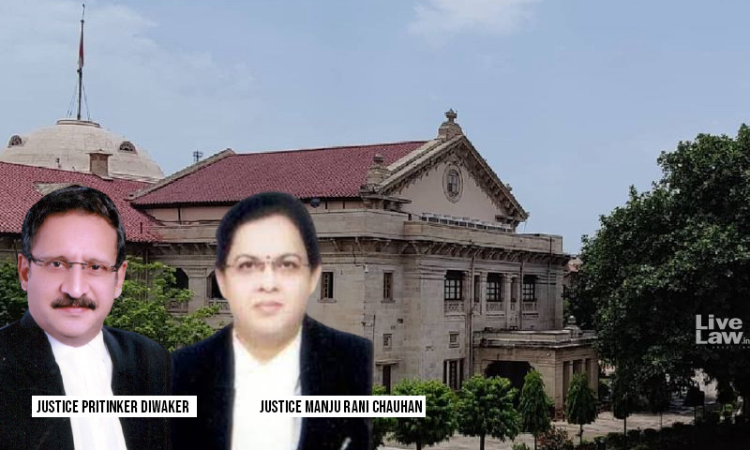- Home
- /
- News Updates
- /
- Fracture Of Hyoid Bone Often Found...
Fracture Of Hyoid Bone Often Found In Strangulation Cases & Not In Suicide Cases: Allahabad HC Dismisses Murder Convict's Appeal
Sparsh Upadhyay
17 Sept 2021 12:11 PM
The Allahabad High Court last week dismissed an appeal filed by a Murder convict who killed his own wife by strangulation inside the privacy of the house (in the bedroom) where the deceased/wife was along with the appellant/husband. The Bench of Justice Pritinker Diwaker and Justice Manju Rani Chauhan perused the post-mortem report of the deceased and noted that it clearly indicated that...
The Allahabad High Court last week dismissed an appeal filed by a Murder convict who killed his own wife by strangulation inside the privacy of the house (in the bedroom) where the deceased/wife was along with the appellant/husband.
The Bench of Justice Pritinker Diwaker and Justice Manju Rani Chauhan perused the post-mortem report of the deceased and noted that it clearly indicated that the instant case was not a case of suicide, but was a case of murder.
The Court also underscored that as per medical jurisprudence, fracture of the hyoid bone is often found in the case of strangulation and not in the case of suicide.
The Case in brief
The Accused had been convicting under Section 302 of I.P.C. and was sentenced to undergo imprisonment for life with a fine of Rs. 10,000/-, in default thereof, to undergo three months additional imprisonment for killing his wife in the year 2014 by strangulation.
The cause of the death, as per medical records, was defined as asphyxia due to antemortem injury. It may be noted that Asphyxia or asphyxiation is a condition of the deficient supply of oxygen to the body that arises from abnormal breathing. This meant, that either the death occurred due to strangulation or due to suicide.
Arguments advanced
The defence argued that the relatives, including the mother and father, of the deceased, were declared hostile and that the deceased had some mental ailment and out of frustration, she committed suicide.
It was also argued that there was no evidence on record to show that at the time of occurrence, the appellant was also present in the house and that even if it is accepted that the husband/accused was present there, it cannot be said that it is the appellant alone, who committed the murder of his wife.
On the other hand, the prosecution argued that that the deceased died homicidal death in her bedroom and it was the duty of the appellant/accused/husband to offer plausible, acceptable explanation, which he utterly failed to do and therefore, the court below was justified in convicting him with the aid of Section 106 of Evidence Act.
Court's observations
At the outset, the court observed that the accused side had admitted some documents under Section 294 Cr.P.C., including the Inquest report, the Postmortem Report and the Site Plan.
Further, the Court noted that in the site plan (admitted by the defence), the place of occurrence had been shown as the bedroom and then certain other rooms and that, as per the post-mortem report (again, admitted by the defence), injuries have been found on the neck of the deceased and her hyoid bone was found fractured.
Now, against this backdrop, the Court noted that even though the prosecution witnesses turned hostile, but, the homicidal death of the deceased in her matrimonial house had been duly proved by the prosecution.
"There is absolutely no dispute or whisper of evidence that the place of occurrence was not the bedroom of the accused-appellant and the deceased. Even a bare perusal of the site plan reflects that the incident occurred in the bedroom. The appellant has completely failed to demolish the prosecution case based on the site plan. Likewise, there is no dispute about the homicidal death of the deceased. In the evidence, it has also come that at the time of occurrence, the appellant was present in the house and the deceased was taken to hospital by the members of her matrimonial house."
Further, the Court opined that in a case where house murder is the issue, a heavy burden is on the shoulders of the accused to explain as to under what circumstances the deceased died, however, in the instant case, the Court noted, no such explanation had come from the accused side.
Importantly, the Court also underscored that the assailant had all the opportunity to plan and commit the crime at the time and in the circumstances of his choice and that it was extremely difficult for the prosecution to lead evidence to establish the guilt of the accused, if the strict principle of circumstantial evidence has been insisted upon.
Referring to the 22nd Edition of Modi's Medical Jurisprudence and Toxicology, the Court noted that since the face of the deceased was congested and blood was coming from her nose, it was suggestive of the fact that the cause of death was strangulation and not suicide.
Consequently, the Court came to the conclusion that the prosecution had collected sufficient evidence to hold the accused/appellant guilty for committing the murder of his wife and that way, the Court below was justified to convict the accused under Section 302 IPC.
Case title - Dharmendra Nishad v. State of U.P.
Click Here To Download Judgment
Read Judgment

